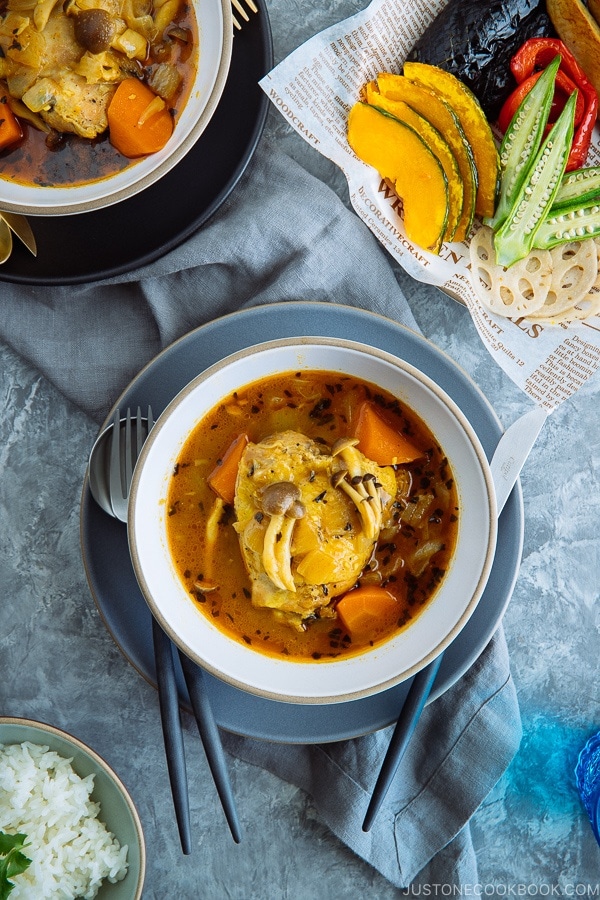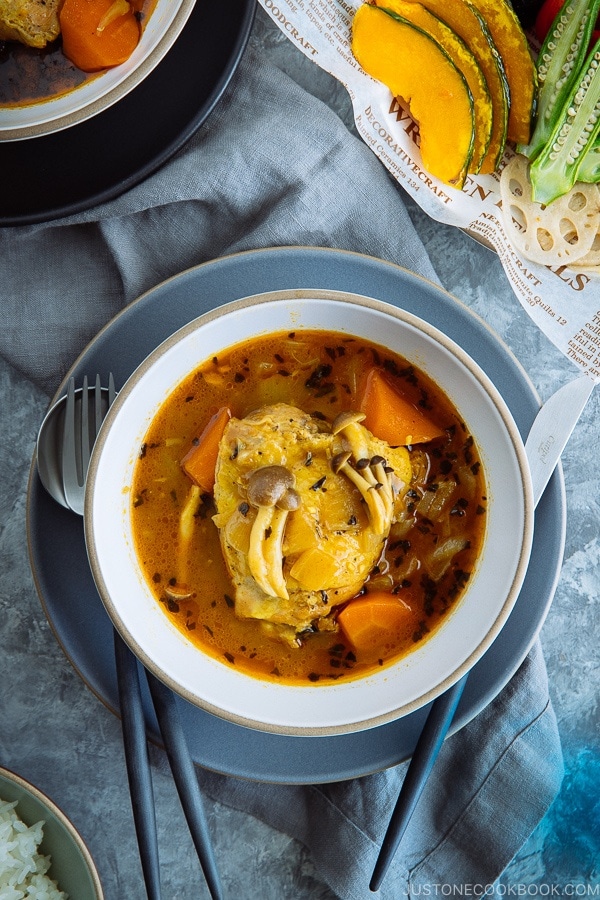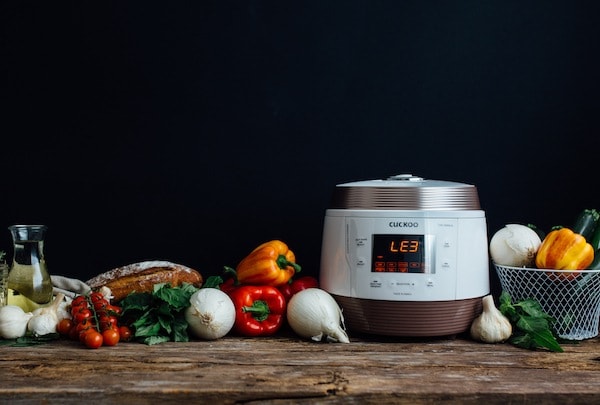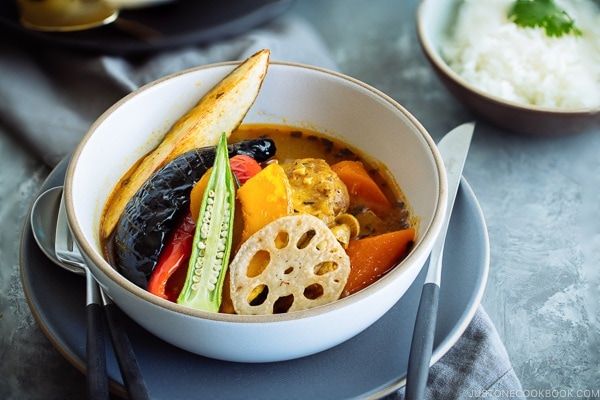Originated in Sapporo, Hokkaido, a northernmost island of Japan, Soup Curry is a light curry flavored soup served with fall-off-the-bone chicken and colorful vegetables that are flash fried to give the vibrant colors. It’s relatively a new addition to the popular Japanese curry scene.
Most notably known as the birthplace of the oldest beer in Japan, Sapporo, the capital of Hokkaido, is also a food lovers paradise. You can find incredibly fresh seafood, seasonal vegetables from local farms and high-quality dairy products, all of which contribute to its thriving food scene.
Aside from the famous soft-serve ice cream, snow crab, and jingisu kan (barbecue-style mutton dish), another local specialty that any visitors to the snowy city must try is Soup Curry (スープカレー). Served piping hot and filled with nutritious ingredients and flavorful spices, this amazing curry dish is one of the best cure-alls on a cold, snowy day, or any day when your curry craving hits.
Watch How to Make Soup Curry
Originated in Sapporo, Hokkaido, a northernmost island of Japan, Soup Curry is a light curry flavored soup served with tender chicken chicken and colorful vegetables.
What is Soup Curry?
The original soup curry was firstly created by a cafe in Sapporo in the early 70’s. Inspired by a Chinese/Korean medicinal soup and curry from Indonesia, Thailand, Sri Lanka, and India, it was a clever adaptation of all these different influences with local elements in mind. By 2000’s, more specialty shops started popping up everywhere in Sapporo and soup curry became Sapporo’s new signature dish.
The typical soup curry consists of the following: a light curry flavored soup, chicken leg, and non-battered deep-fried vegetables (“suage”-style, 素揚げ) such as eggplants, potatoes, carrots, bell peppers, okra, and kabocha squash. Unlike the typical Japanese curry, steamed rice is always served separately. You scoop up the rice and then dip into the soup curry to enjoy together. When you’re almost done with the rice, you transfer the remaining rice into the soup curry and enjoy the last bits together.
With so much vibrancy and comfort that comes with the curry, it is no wonder the locals go wild about it. There’s no better way to keep you through the long winter nights with this restorative dish.
5 Interesting Features of Soup Curry
1. Soupy
As the name suggests, soup curry is soupy – it’s thin and watery, not thick like the regular Japanese curry.
2. Layers of spices
When Japanese make curry, we rely on the store-bought curry roux like this. However, for soup curry, you add more spices like curry powder, garam masala, basil, etc. The fun part of this recipe is you can create your own spice blend for the soup curry and easily adjust to your own likings. My friend who helped me create this recipe uses honey and mango chutney. My kids and I love these additions in our soup curry as well.
3. Colorful and Chunky Ingredients
Soup curry has very colorful and chunkier vegetables as you don’t cook them in the curry with meat and stock. Instead, vegetables are deep fried without batter (Japanese “su-age” technique) and served on top of the curry at the end. More about “su-age” technique later.
4. Varying Textures
You get to enjoy fall-off-the-bone chicken, tender carrots, and crisp deep-fried vegetables all in one bowl. The varying textures add a distinctive presentation and enjoyment to the curry dish.
5. Rice is Served Separately
Unlike a typical Japanese curry, steamed rice is served in a separate bowl or a plate.
What is Su-age (素揚げ)?
Su-age is basically flash fry without coating any flour or batter. Su means natural or uncoated in this case and age (pronounce a-geh) means deep frying. Cooking time varies from 30 seconds (bell peppers) to 3 minutes (potatoes).
This traditional Japanese cooking technique is used to preserve or intensify ingredients’ original flavors, vibrant colors, and shapes. I have used this technique in recipes like Eggplant Agebitashi and Sweet and Sour Chicken.
Trying Out Cuckoo Multi Cooker
I’ve partnered with Cuckoo Electronics America today to create this soup curry recipe using their brand new Cuckoo Multi Cooker, ICOOK Q5, and I’m giving away 3 Multi Cookers to JOC readers (US only). To enter the giveaway, please click here.
5 Reasons Why Cuckoo is Appealing
Besides the beautiful design that you want to it put on your kitchen counter, here are 5 things I like about Cuckoo:
- Cuckoo is a multi-cooker (8 functions), so you can make rice, yogurt, soup, steam, slow cook, pressure cook, brown food, and keep warm. All in one machine!
- Its inner pot has a non-stick coating, so you can make steamed rice with this cooker and NO single rice goes to waste (THANK YOU!).
-
It includes steam release function during the cooking process. It’s super safe.
-
This machine auto cleans! Yes, you heard me right; it cleans itself. No more issue with smelly pot and lid.
-
Cuckoo comes with a voice guidance. Just like Google map. Cuckoo, please navigate me as I follow you.
If you’re using a pressure cooker, making the soup curry itself is a doable task. The flash-frying is where it takes a little longer time. You can choose to skip the deep-fried vegetables, but then again, who wants to miss out the best part of this delicious dish. So, if you’re going to make this Sapporo-signature soup curry, go ahead and indulge yourself. It’s totally worth the effort!
Don’t want to miss a recipe? Sign up for the FREE Just One Cookbook newsletter delivered to your inbox! And stay in touch with me on Facebook, Google+, Pinterest, and Instagram for all the latest updates.
Thank you to Cuckoo Electronics America for sponsoring this post!
Soup Curry
For Steamed Rice
- 2 rice cooker cups uncooked Japanese short grain rice
- water ((Fill up till 2 cup line))
For Soup Curry
- 1 onion
- 1 carrot
- 1 package shimeji mushrooms
- 3 cloves garlic
- 1 knob ginger
- 2.5 lb bone-in, skin-on chicken thighs ((6 pieces))
- 1 tsp kosher salt ((for chicken))
- freshly ground black pepper
- ½ Tbsp extra virgin olive oil
- 1 Tbsp unsalted butter
- ¼ tsp kosher salt ((for onion))
- 3 cups chicken stock/broth
- 1 Tbsp dry basil
- 1 bay leaf
- 1 tsp kosher salt ((to taste))
- 1 tsp soy sauce
Seasonings
- 1 piece Japanese curry roux ((= 1 small square block))
- 1 Tbsp curry powder
- 1 tsp garam masala
- 1 Tbsp tomato paste
- 1 Tbsp honey
- 1 ½ Tbsp mango chutney
For Additional Vegetables
- 1 cup neutral flavor oil (vegetable, canola, etc)
- 1 russet potato
- ½ red bell pepper
- 2 okra
- 2 Japanese/Chinese eggplant
- 2 inches lotus root (renkon)
- 2 oz kabocha squash ((60 g))
Make Steamed Rice
- Rinse rice and drain well. Place rice and water in the inner pot of the cooker. Close the lid.
-
Select [Rice] using [MENU] button and set the steam time to 8 minutes. Press [COOK] button. When cooking is completed, warming will start. Fluff up the rice with a rice scooper. Tip: Adjust cooking time and water according to personal taste.
Prepare Ingredients
-
Gather all the ingredients. Once we start cooking, we don’t have time to measure, so make sure to prepare the seasonings ahead of time (1 piece Japanese curry roux, 1 Tbsp curry powder, 1 tsp garam masala, 1 Tbsp tomato paste, 1 ½ Tbsp mango chutney, and 1 Tbsp honey).
- Dice the onion (It doesn’t have to be perfect).
- Cut the carrot into small pieces. I recommend using “rangiri” – a Japanese cutting method to increase the surface. It’ll help cooking evenly and faster, and absorbing more flavors.
- Mince the garlic and grate the ginger.
- Discard the bottom of the shimeji mushroom stem. Roughly separate the mushrooms.
- Pat dry the chicken with paper towel to remove any moisture. Season the chicken with kosher salt and freshly ground black pepper.
Stir Fry
-
Set cooker to [BROWNING FRY, level 6] for 30 minutes (you can add more minutes later on if you need extra time).
-
Heat 1 Tbsp oil and brown the chicken, skin side down, for 5 minutes each side, or until golden brown. Don’t crowd the pot and brown the chicken in batches, if necessary.
- After the bottom side is nicely brown, flip to cook the other side. Then transfer the chicken to a plate and continue with the next batch. Set aside.
-
Add the diced onion and 1 Tbsp unsalted butter. Sauté until translucent, about 7-8 minutes.
- Add the garlic and ginger and mix all together.
- Add 1 piece Japanese curry roux, 1 Tbsp curry powder, and 1 tsp garam masala. Give it a quick stir.
- Add 1 Tbsp tomato paste and sauté until fragrant.
- Add 1 Tbsp honey and 1 ½ Tbsp mango chutney and mix all together.
- Gradually add half the chicken broth, scraping the brown bits on the bottom of the pot. Transfer the chicken back to the pot.
- Add the carrots, shimeji mushrooms, and the rest of chicken broth.
- Add 1 Tbsp dry basil and 1 bay leaf. Gently mix all together.
Pressure Cooking
-
Close the lid and set cooker to [MULTI COOK, level 9] for 35 minutes. For Instant Pot directions, see Notes.
-
Once the pressure cooking is done, open the lid and stir. Add 1 tsp kosher salt and 1 tsp soy sauce.
- Taste and adjust the flavor.
Deep Fry Vegetables (Optional)
- Lotus root: Slice thinly and soak in water (or ideally 2 cups water + 1 tsp of rice vinegar) for 10 minutes.
- Bell pepper: Remove the seeds and cut into 4 wedges.
- Okra: Remove the hard corners and cut in half lengthwise.
- Kabocha: Thinly slice the kabocha (cut in half if it’s too big). If the kabocha is too hard to cut, microwave for 30 seconds or more if it’s still hard.
- Potato: Cut into 6 to 8 wedges and soak in water to remove starch for 10 minutes.
- Eggplant: Right before deep frying (otherwise it’ll change color), cut the eggplants in half and cut the skin side in criss-cross pattern. This creates a nice design and helps to absorb more flavors.
-
Make sure to remove moisture from all the vegetables with paper towel or kitchen towel before frying.
-
Add 1 cup of oil in a frying pan (I used a cast iron pan) or pot. Deep/shallow fry the vegetables at 350 ºF (175 ºC) and drain the excess oil on a paper towel or a wire rack.
Serve
- Serve the steamed rice in a small bowl or plate and the soup curry in a bowl. Top the soup curry with deep fried vegetables. When you eat, pick up some rice with a spoon, and scoop soup curry. Enjoy!
Instant Pot users: Use [Saute] mode to brown the chicken. Then for pressure cooking, set to [Manual, High Pressure] for 15 minutes. Make sure the steam release handle points at “sealing” and not “venting”. Expect pressure cooking takes 10-15 minutes to reach pressure before the cooking program starts, and another 15-25 minutes to naturally release pressure. When the pot is 2/3 of the way full, I highly recommend natural release.
Recipe by Namiko Chen of Just One Cookbook. All images and content on this site are copyright protected. Please do not use my images without my permission. If you’d like to share this recipe on your site, please re-write the recipe in your own words and link to this post as the original source. Thank you.
The post Soup Curry 札幌スープカレー appeared first on Just One Cookbook.
Resource : https://ift.tt/2vMxpFu









No comments:
Post a Comment